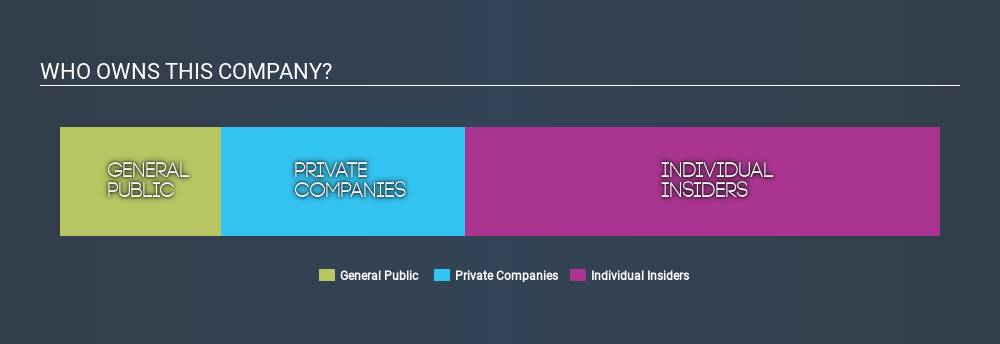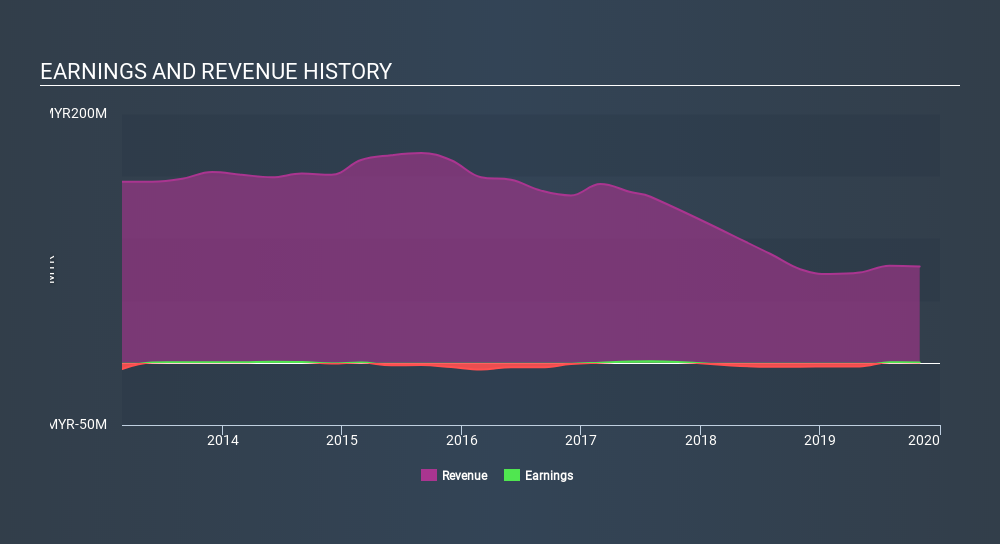Could The Saudee Group Berhad (KLSE:SAUDEE) Ownership Structure Tell Us Something Useful?

If you want to know who really controls Saudee Group Berhad (KLSE:SAUDEE), then you'll have to look at the makeup of its share registry. Institutions will often hold stock in bigger companies, and we expect to see insiders owning a noticeable percentage of the smaller ones. I quite like to see at least a little bit of insider ownership. As Charlie Munger said 'Show me the incentive and I will show you the outcome.
Saudee Group Berhad is a smaller company with a market capitalization of RM41m, so it may still be flying under the radar of many institutional investors. In the chart below, we can see that institutions are not on the share registry. We can zoom in on the different ownership groups, to learn more about Saudee Group Berhad.
Check out our latest analysis for Saudee Group Berhad

What Does The Lack Of Institutional Ownership Tell Us About Saudee Group Berhad?
Small companies that are not very actively traded often lack institutional investors, but it's less common to see large companies without them.
There could be various reasons why no institutions own shares in a company. Typically, small, newly listed companies don't attract much attention from fund managers, because it would not be possible for large fund managers to build a meaningful position in the company. It is also possible that fund managers don't own the stock because they aren't convinced it will perform well. Saudee Group Berhad might not have the sort of past performance institutions are looking for, or perhaps they simply have not studied the business closely.

Saudee Group Berhad is not owned by hedge funds. With a 24% stake, CEO Khang Tan is the largest shareholder. Next, we have Wide Symbol Sdn Bhd and Lay Khoo as the second and third largest shareholders, holding 23% and 8.7%, of the shares outstanding, respectively. Interestingly, Lay Khoo is also a Chairman of the Board, again, indicating strong insider ownership amongst the company's top shareholders.
Our analysis suggests that the top 3 shareholders collectively control 55% of the company's shares, implying that they have considerable power to influence the company's decisions.
Researching institutional ownership is a good way to gauge and filter a stock's expected performance. The same can be achieved by studying analyst sentiments. As far I can tell there isn't analyst coverage of the company, so it is probably flying under the radar.
Insider Ownership Of Saudee Group Berhad
While the precise definition of an insider can be subjective, almost everyone considers board members to be insiders. The company management answer to the board; and the latter should represent the interests of shareholders. Notably, sometimes top-level managers are on the board, themselves.
I generally consider insider ownership to be a good thing. However, on some occasions it makes it more difficult for other shareholders to hold the board accountable for decisions.
It seems that insiders own more than half the Saudee Group Berhad stock. This gives them a lot of power. That means they own RM22m worth of shares in the RM41m company. That's quite meaningful. Most would be pleased to see the board is investing alongside them. You may wish todiscover (for free) if they have been buying or selling.
General Public Ownership
With a 18% ownership, the general public have some degree of sway over SAUDEE. This size of ownership, while considerable, may not be enough to change company policy if the decision is not in sync with other large shareholders.
Private Company Ownership
It seems that Private Companies own 28%, of the SAUDEE stock. It's hard to draw any conclusions from this fact alone, so its worth looking into who owns those private companies. Sometimes insiders or other related parties have an interest in shares in a public company through a separate private company.
Next Steps:
I find it very interesting to look at who exactly owns a company. But to truly gain insight, we need to consider other information, too. For example, we've discovered 4 warning signs for Saudee Group Berhad (1 shouldn't be ignored!) that you should be aware of before investing here.
Of course this may not be the best stock to buy. Therefore, you may wish to see our free collection of interesting prospects boasting favorable financials.
NB: Figures in this article are calculated using data from the last twelve months, which refer to the 12-month period ending on the last date of the month the financial statement is dated. This may not be consistent with full year annual report figures.
If you spot an error that warrants correction, please contact the editor at editorial-team@simplywallst.com. This article by Simply Wall St is general in nature. It does not constitute a recommendation to buy or sell any stock, and does not take account of your objectives, or your financial situation. Simply Wall St has no position in the stocks mentioned.
We aim to bring you long-term focused research analysis driven by fundamental data. Note that our analysis may not factor in the latest price-sensitive company announcements or qualitative material. Thank you for reading.
About KLSE:SG
SaudiGold Group Berhad
An investment holding company, produces and sells processed poultry, beef products, frozen food, and bakery products in Malaysia.
Flawless balance sheet and slightly overvalued.
Market Insights
Community Narratives





